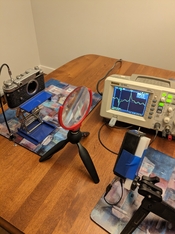Individual One
Member
Timers for focal plane shutters, using a light source and a detector located on opposite sides of a focal plane shutter are all over the internet. As they use transmitted light, they require a camera with an opening or removable back.
I wanted to adapt this existing technology to enable it to be used on a Barnack style Leica or one of the many copies, that do not have an opening. I have a Nicca, a fairly high fidelity copy of a Leica III series camera and as it is working fine I don't want to dismantle it to make shutter speed measurements in transmitted mode.
It seemed to me that a detector staring at a laser spot on the film plane should work. It should be able to detect the brightness changes as the shutter opens and closes again. To increase the signal I placed a piece of reflective fabric that I happened to have left over from a sewing project in the shutter opening on the film plane, and relayed the spot on the film plane to the detector using a lens salvaged from a magnifying glass. To my surprise it worked. Because my Nicca currently has film in it I used a FED camera as a stand-in, but I think the system would work for focal plane shuttered rangefinder cameras in general. As with transmitted systems, the camera can be moved around to measure times at any location in the shutter opening to provide information about relative curtain speed. I have not tried it on a SLR but it would have more complex reflections for the timer to discriminate.
Here is a picture of the system in use:

And, here is the detector output at 1/30 shutter speed. Note that the detector sees the change in brightness as the shutter curtain passes from cloth to metal edge to reflective fabric.

I hope this idea can be of use to others with barnack style cameras.
(edit: this is a work in progress)
After I posted this I tried a different magnifying glass to relay the image. It works much better, giving a stronger and cleaner signal for the detector to work with.
Picture attached of a 1/60 test:

And another edit. I finished the film in the Nicca, so I could test the camera on my new setup.
Turns out it is overexposing by about 1/2 stop across the range. (The dark curves on the graph are +/- 0.5 stops)
Not that bad for a 70 year old machine, and easily compensated for.

Bruce
I wanted to adapt this existing technology to enable it to be used on a Barnack style Leica or one of the many copies, that do not have an opening. I have a Nicca, a fairly high fidelity copy of a Leica III series camera and as it is working fine I don't want to dismantle it to make shutter speed measurements in transmitted mode.
It seemed to me that a detector staring at a laser spot on the film plane should work. It should be able to detect the brightness changes as the shutter opens and closes again. To increase the signal I placed a piece of reflective fabric that I happened to have left over from a sewing project in the shutter opening on the film plane, and relayed the spot on the film plane to the detector using a lens salvaged from a magnifying glass. To my surprise it worked. Because my Nicca currently has film in it I used a FED camera as a stand-in, but I think the system would work for focal plane shuttered rangefinder cameras in general. As with transmitted systems, the camera can be moved around to measure times at any location in the shutter opening to provide information about relative curtain speed. I have not tried it on a SLR but it would have more complex reflections for the timer to discriminate.
Here is a picture of the system in use:

And, here is the detector output at 1/30 shutter speed. Note that the detector sees the change in brightness as the shutter curtain passes from cloth to metal edge to reflective fabric.

I hope this idea can be of use to others with barnack style cameras.
(edit: this is a work in progress)
After I posted this I tried a different magnifying glass to relay the image. It works much better, giving a stronger and cleaner signal for the detector to work with.
Picture attached of a 1/60 test:

And another edit. I finished the film in the Nicca, so I could test the camera on my new setup.
Turns out it is overexposing by about 1/2 stop across the range. (The dark curves on the graph are +/- 0.5 stops)
Not that bad for a 70 year old machine, and easily compensated for.

Bruce
Last edited:




